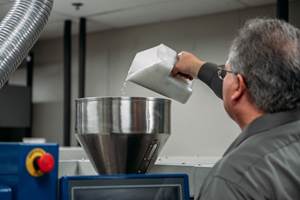Used Car Windshields Are Reborn As Carpet Backing
Two years ago, the Kaiser Permanente hospital chain challenged its two institutional carpet suppliers to come up with a carpet containing no PVC.
Two years ago, the Kaiser Permanente hospital chain challenged its two institutional carpet suppliers to come up with a carpet containing no PVC. Whoever succeeded first would win all their 911±¬ÁĎÍř. C&A Floorcoverings won the $5-million contract (which includes 20 new hospitals) and a slew of environmental awards. Its main competitor didn't even submit a proposal. And the new carpet backing costs no more than C&A's standard recycled PVC backing.
C&A Floorcoverings Inc., Dalton, Ga., the commercial carpeting 911±¬ÁĎÍř spun off in 1997 from Collins & Aikman, did what it has done numerous times before—it beat the competition by developing a unique recycled material. It invented a tough, flexible carpet backing called "ethos" (patent pending), based on polyvinyl butyral (PVB) recycled from auto safety glass.
For 10 years, C&A has recycled vinyl-backed carpet or carpet tiles, which are mostly nylon, though some are wool. Because C&A's customers are commercial institutions like banks and hotel chains, which redo their carpet an average of every three to six years, collection is easy. Some customers ask for new carpet made with their own old carpet. C&A is able to oblige by tracking where waste carpet comes from and where it goes.
First melt-recycled PVB
C&A senior research chemist Brian Randall recalls searching the internet for suppliers of recycled plastic materials to see what was out there. PVB was available from glass recyclers in the form of a soft flake. The vast majority was landfilled because it was contaminated with glass, metal, and rubber window-gasket residue.
Contaminants weren't a problem for C&A's carpet backing. The company accepts contaminants as fillers and adds even more finely ground, recycled glass to the formulation. The recycled PVB material was designed to drop into C&A's existing twin-screw compounding and calendering system used to make recycled PVC carpet backing.
The recycling process was developed by C&A operators, who modified equipment originally used to extrude hot melt out of a film die directly onto carpet. The film die was replaced with a 2-in. round die, and a calender was added.
Post-consumer, PVC-backed waste carpet is first steam cleaned for the comfort of C&A's workers. (Dirty carpet smells bad and could be a health hazard.) The cleaned carpet is then shredded, ground, and densified. Industrial PVC automotive scrap is also added.
C&A uses a Condux agglomerator to soften and compact the PVC without melting the nylon fiber, creating crumbles of flexible, fiber-filled PVC. Densifying the material increases the feed rate through the twin-screw compounding extruder and sheet line.
The compounder ex trudes a 2-in.-diam. gray rope of "old carpet goo," as C&A's Randall puts it (see photo). The rope travels about 20 ft from the extruder to the sheet line, where it's fed in a loose figure eight into the calendering rolls. The result is 50-mil-thick carpet backing, which is trimmed and rolled.
C&A also adds a chemical foaming agent to foam both the PVC and PVB backing. So when the sheet goes through the oven, the backing expands two or three fold into 100- to 150-mil-thick cushion.
C&A uses 96% to 100% post-consumer recycled material in all its carpet and carpet tiles. Since 1994, it has reclaimed over 100 million lb of post-consumer, PVC-backed carpet. And in the first year since launching the PVB backing, it has already used about 300,000 lb of post-consumer PVB.
When used PVB-backed carpet comes back, small amounts can go right into C&A's existing PVC backing. In addition, C&A is developing a PVB-backed carpet tile, which will include reclaimed PVB-backed carpet.
Related Content
Novel Line Turns Fluff to Blown Film
Processor Bioflex of Mexico is utilizing Reifenhäuser Blown Film’s EVO Fusion technology to integrate postindustrial and postconsumer recycled materials into products.
Read MoreMarket Changes Spur Industrial Recycler to Enhance Capabilities in Clear Plastic Reprocessing
Butler MacDonald found new 911±¬ÁĎÍř and flexibility thanks to a big step-up in purging efficiency.
Read MoreStar Plastics Achieves ISCC Plus Certification
West Virginia-based custom compounder adds to its sustainability credentials.
Read MoreInside the Florida Recycler Taking on NPE’s 100% Scrap Reuse Goal
Hundreds of tons of demonstration products will be created this week. Commercial Plastics Recycling is striving to recycle ALL of it.
Read MoreRead Next
Beyond Prototypes: 8 Ways the Plastics Industry Is Using 3D Printing
Plastics processors are finding applications for 3D printing around the plant and across the supply chain. Here are 8 examples to look for at NPE2024.
Read MorePeople 4.0 – How to Get Buy-In from Your Staff for Industry 4.0 Systems
Implementing a production monitoring system as the foundation of a ‘smart factory’ is about integrating people with new technology as much as it is about integrating machines and computers. Here are tips from a company that has gone through the process.
Read MoreFor PLASTICS' CEO Seaholm, NPE to Shine Light on Sustainability Successes
With advocacy, communication and sustainability as three main pillars, Seaholm leads a trade association to NPE that ‘is more active today than we have ever been.’
Read More












